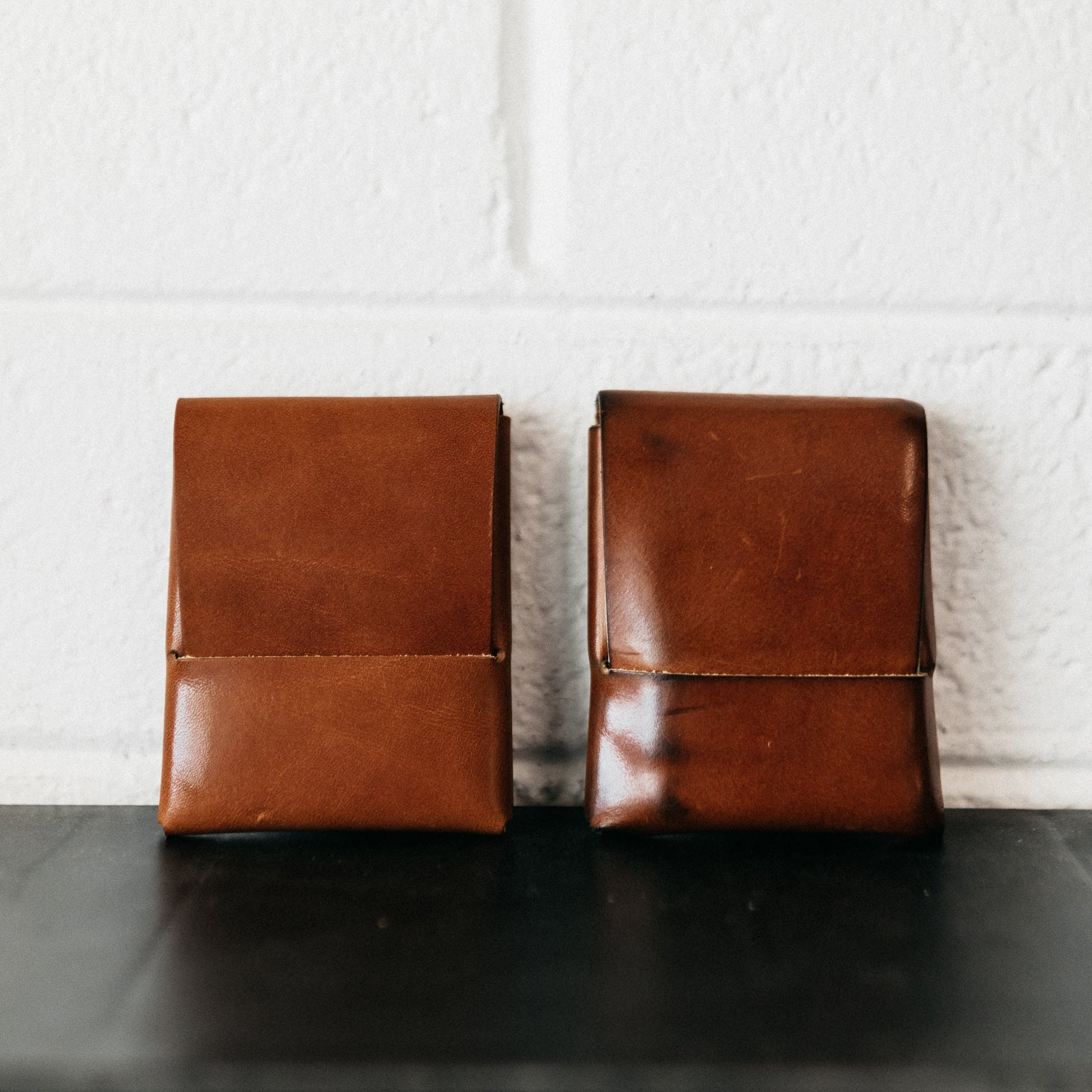
Waxed Leather vs Natural Finish Leather: Complete Comparison
Leather is one of those materials that becomes more personal the longer you use it. Two wallets may start out looking similar, but after a few years in different hands, they tell entirely different stories. The type of leather you choose plays a huge role in how that story unfolds.
Among the most talked-about finishes are Waxed Leather and Natural Finish Leather. Each has its own personality, its own way of aging, and its own set of strengths. Understanding the differences helps you decide whether you need rugged resilience or raw elegance for your next wallet, belt, or everyday accessory.
What Is Waxed Leather?
Waxed leather is leather that’s been infused with natural waxes like beeswax or paraffin. These waxes penetrate the fibers and create a protective barrier. The result is leather that’s tough, water-resistant, and full of character.
Scuffs and scratches don’t ruin waxed leather; they add to its appeal. Marks highlight the natural variations of the hide, and over time, the surface develops a rich, lived-in look. Items like The Franklin wallet capture this balance perfectly: tough enough for daily wear, refined enough to carry anywhere.
Analogy: Waxed leather is like a waxed canvas jacket. At first, it’s sturdy and protective. Years later, it’s a map of your experiences, each crease and mark telling part of your story.
What Is Natural Finish Leather?
As its name suggests, Natural Finish Leather is leather left closer to its raw state. It isn’t coated or heavily altered. Instead, it showcases the grain, the small imperfections, and the unique story of the hide.
This kind of leather appeals to purists. It feels warm and organic in your hand, often with a matte appearance that gradually darkens as it absorbs oils from your skin. A piece like The Dutchman wallet showcases this beauty, classic, understated, and refined.
Analogy: Natural finish leather is like an unpolished stone. Its beauty lies in what nature left behind, not in how much we altered it.
Appearance and First Impressions
At first glance, the finishes couldn’t be more different.
-
Waxed Leather has a slightly glossy, waxy feel. It may look rugged or even a little oily to the touch, but that’s what makes it resilient. Over time, the surface shifts, scratches soften, and the sheen deepens into a rugged patina.
-
Natural Finish Leather starts off matte and soft, showing subtle grain lines and tonal variation. It doesn’t have a protective shield, so scratches stand out more at first. With age, though, it develops a subtle glow and a warm depth that’s intimate and personal.
Where waxed leather makes an immediate statement, natural finish leather whispers quietly, rewarding patience.
Durability and Everyday Use
Waxed Leather is built for daily abuse. The wax strengthens the fibers, making them less prone to cuts, tears, or deep scuffs. It also adds some water resistance, which makes it ideal for belts, work bags, or everyday wallets that see heavy handling. A piece like The Vertical Dutchman card holder thrives in this environment.
Natural Finish Leather, while durable in its own right, is more delicate. Keys in a pocket, spills on a desk, or a scuffed corner will leave visible marks. For people who see these marks as part of the leather’s charm, that’s not a flaw. It’s the point. Items like The Mini Franklin embody this, slim, refined, and meant to age into a deeply personal piece.
Story: A craftsman once told of a customer who carried a natural-finish wallet for years. The scratches from coins, the shine from daily handling, and the darkened tone told a story of countless mornings, meetings, and milestones. What began as pale leather had become a soft, chestnut heirloom.
Patina: Two Different Journeys
Both waxed and natural finish leather develop patina, but the process is distinct.
-
Waxed Leather Patina: Scratches blend, dark areas highlight, and the wax creates contrast that makes the patina bold and dramatic. It looks rugged and adventurous.
-
Natural Finish Patina: The changes are subtler. The surface slowly darkens, edges soften, and the leather glows. It feels elegant, intimate, and refined.
Both are beautiful, but they suit different personalities. One tells the story loudly, the other quietly.
Maintenance and Care
Waxed Leather is low-maintenance. Most of the time, a quick wipe-down is enough. If the surface begins to lose water resistance, a light reapplication of wax restores it. It’s forgiving and easy to care for.
Natural Finish Leather needs more attention. Regular conditioning prevents it from drying out and cracking. A soft cloth and a quality conditioner every few months will keep it supple. Because it lacks a protective layer, spills and stains should be addressed immediately.
For small items like leather coasters, natural finish leather rewards this care routine with a beautiful glow.
Water Resistance
Water is one of leather’s greatest challenges.
-
Waxed Leather naturally repels moisture. A light rain or accidental spill won’t ruin it. This makes it a strong choice for belts like The Belt, which see daily exposure to the elements.
-
Natural Finish Leather absorbs water quickly. It stains and darkens if not dried properly. While not a deal-breaker, it does mean extra vigilance is needed.
If you live in a rainy climate or carry items outdoors often, waxed leather may be the more practical choice.
Environmental Considerations
Both waxed and natural finish leathers can be environmentally responsible, depending on how they’re tanned. Vegetable tanning, for example, uses plant-based tannins and produces long-lasting hides without harsh chemicals.
Lost Dutchman Leather works with American tanneries that embrace these methods, ensuring both waxed and natural finish pieces, whether a lanyard or a catch-all tray, are made with sustainability in mind.
Cost and Value
Waxed and natural finish leathers are often priced similarly, with slight variations depending on the tannery and treatment. The real distinction isn’t in the upfront cost but in the value over time.
-
Waxed leather offers resilience and low maintenance, making it excellent for long-term daily use.
-
Natural finish leather offers beauty and intimacy, rewarding the owner with a personal, evolving piece if cared for properly.
Both provide far greater value than cheaper alternatives like bonded leather, which peel and crack long before either waxed or natural finish leather shows its true beauty.
Which Leather Fits Your Life?
Here’s how to think about the decision:
Choose Waxed Leather if:
-
You want durability and water resistance.
-
You prefer a rugged, adventurous patina.
-
You need a piece that can take abuse without worry.
Choose Natural Finish Leather if:
-
You love raw, authentic beauty.
-
You don’t mind a little extra care.
-
You want a subtle, elegant patina that reflects your lifestyle.
For something like an AirTag Keyring, waxed leather makes sense; it’s handled constantly and benefits from the extra protection. For a classic wallet or refined accessory, natural finish leather offers unmatched elegance.
Final Thoughts
The choice between Waxed Leather and Natural Finish Leather isn’t about which is better. It’s about which is better for you. Both are strong, beautiful, and capable of lasting decades. The difference lies in personality. Do you want a companion that wears its adventures boldly, or one that whispers its story slowly?
Explore the full wallets collection at Lost Dutchman Leather to see both finishes in action. From rugged belts to refined wallets, every piece is crafted to last. For questions or advice, get in touch, and we’ll help you find the leather that fits your lifestyle.


